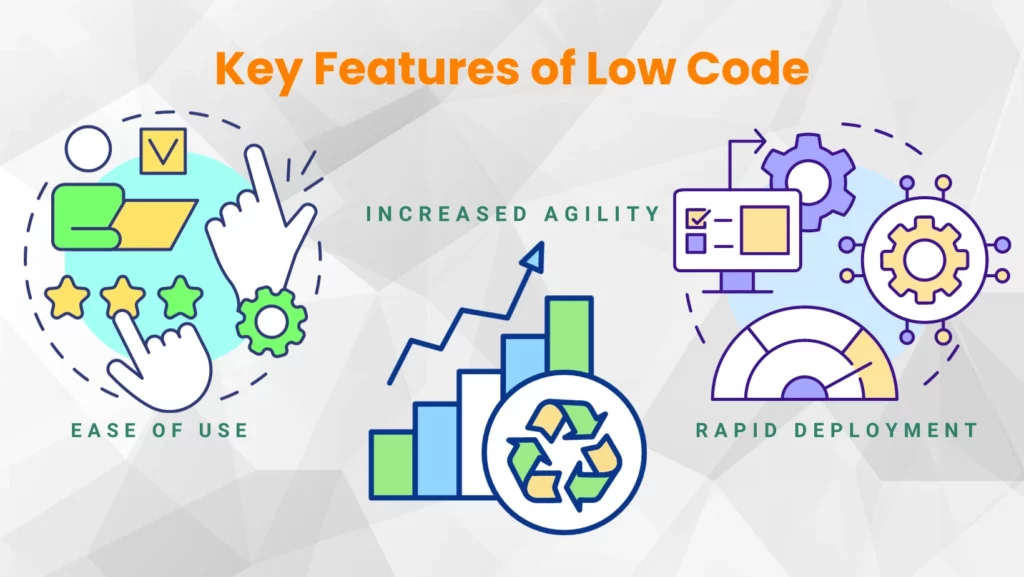Low-code technology is a relatively new concept that’s rapidly changing the way businesses create solutions to their problems. Low Code is designed to make software development simpler and more cost-effective, without compromising quality. But like with everything else, there are certain limitations you should be aware of before adopting this technology into your workflow.
In this article, I’ll explain what these limitations are and how they may affect your organization’s development efforts. So if you’re considering investing in Low Code platforms or simply want to learn more about its potential pitfalls, read on!
Table of contents
- Are you considering a low-code platform?
- What is Low Code and why is it useful for Businesses to use it?
- Identifying the Key Features of Low Code
- The limitations of Low Code – What it cannot do?
- Understanding how an effective low-code strategy can help companies overcome its limitations
- Tips on How to make sure your low-code solution meets all your business needs
- Frequently Asked Questions About Understanding What are the Limitations of Low Code
- Conclusion
Are you considering a low-code platform?
Low code is designed to help speed up development, but there are inherent limitations. Understanding the capabilities and restrictions of any technology before committing to it can save time, money, and frustration in the long run.
Take advantage of our free guide that examines all the potential limitations and whether or not they’ll have an impact on your project. See how you can get the most out of low code without running into roadblocks down the line. Keep reading.
Keep reading and understand the Low Code platform more!
What is Low Code and why is it useful for Businesses to use it?

Low code refers to a type of technology platform that makes it easier to develop applications without having to write code. It also reduces the learning curve associated with traditional programming languages and requires less technical expertise, making it an attractive option for businesses of all sizes.
Low code development platforms are designed to make creating software faster and easier than traditional development methods. It allows programmers, business professionals, or even people with no programming experience at all the ability to create user-friendly apps with little effort.
Low code is great for businesses that need applications quickly without having to find and hire skilled developers for every project. Low code can also help smaller businesses rapidly develop applications without having to invest a lot of money.
Did you know?
- 82% of the businesses feel citizen developers will become more important in two years.
- In 2021, the low-code platform market was valued at $7.61 billion. It’s projected to reach $36.43 billion by 2027.
Identifying the Key Features of Low Code

Low-code solutions are generally made up of several components that make them unique. Many low-code platforms offer drag-and-drop tools, allowing developers to quickly assemble applications without writing code. They also offer pre-built features and templates for developing certain types of applications.
Low-code platforms typically come with integrated security features to protect users when creating, storing, and sharing data. As well, they often offer powerful analytics capabilities to help businesses gain insights from their data and make better decisions.
Some of its Key features you will surely enjoy include:
Ease of use
Low-code platforms are designed to be extremely user-friendly, making it easy for users to pick up and start creating apps without any programming experience. This makes them a great solution for those who don’t have the time or resources to learn coding languages.
Rapid deployment
The rapid application development and deployment features of low-code platforms allow businesses to quickly create applications and get them up and running in no time. This is great for companies that need to launch an application fast to stay competitive or meet customer demands.
Increased agility
The low-code software development process is very agile, meaning you can quickly make changes to the application without having to go through a lengthy development process. This makes it much easier and faster for businesses to respond to customer needs or technological advances in the market.
It’s no surprise that low-code solutions have become so popular with business users alike. With its ease of use, rapid development and deployment capabilities, and increased agility, it’s easy to see why.
The limitations of Low Code – What it cannot do?

With low-code tools, it’s important to remember that they have their limitations and may not be suitable for every type of development project.
Here are the key limitations to consider when looking at low-code solutions:
Complex tasks
Low-code platforms might not be able to perform certain complex tasks like integrating multiple databases or creating custom algorithms. If you’re working on projects that require complicated coding, traditional development methods may still be the best option.
Limited customization
While low-code platforms allow for some customization, they may not be able to accommodate really specific requirements. If you need a highly customized application, low-code probably isn’t the right choice for your project.
Security vulnerabilities
Low-code solutions can come with built-in security features but there is still a security risks that applications could be vulnerable to attack if they are not properly maintained. As such, it’s important to regularly monitor and update the applications as needed to minimize the risk of a security breach.
Version Control and Collaboration
Most low-code platforms don’t have built-in version control and collaboration features, so it may be difficult to track changes or coordinate with other developers. If version control is an important part of your development process, then traditional software development may be a better option.
Lack of Scalability
Low-code applications are often limited in terms of scalability. If you need to build an application that can easily scale up or down according to user demand, then traditional development methods may be the better choice.
Understanding how an effective low-code strategy can help companies overcome its limitations

The low-code development tools are incredibly powerful and have a lot to offer businesses of all sizes. Knowing the key limitations of low-code can help companies create an effective strategy for using them that will ensure they get the most out of their solutions without running into roadblocks down the line.
Some examples to help companies make the most of low code include:
Understanding Your Requirements
Having a clear understanding of your project requirements and needs is essential for creating an effective low-code strategy. Taking the time to thoroughly research the features and capabilities that are available with low-code tools can help you determine if it’s the right fit for your project.
Evaluating Your Team’s Skillset
Low-code solutions require a certain level of technical expertise to use, so it’s important to evaluate your team’s skillset before committing to an approach.
Developing a Plan for Security and Maintenance
It’s important to develop a plan for regularly maintaining and updating your applications to avoid security vulnerabilities. This may include setting up automated testing, monitoring user access, and patching any potential holes in the system.
Investing in Training
Low-code platforms offer pre-built features and templates, but it’s still important to invest in training for your team so they understand how to use them efficiently.
Tips on How to make sure your low-code solution meets all your business needs

Unlike no-code development platforms, low-code platforms require more technical knowledge and skill. As such, it’s important to make sure that the platform you choose can meet all your business needs.
Here are some tips for doing just that:
Invest in Research
Before making any decisions on what platform to use, take the time to research different options and compare their features and capabilities.
Set Clear Goals
Having a clear understanding of your goals and objectives for the project can help ensure that the platform can meet those requirements.
Test the Platform
Once you’ve settled on a platform, it’s important to test it out to make sure that it meets all your needs. If any issues arise during the testing process, this can help identify them early on and prevent potential problems down the line.
Consult with Experts
Consulting with experts can be a great way to ensure that you make the right decision when it comes to choosing a low-code platform. Having experts with experience in the field review your requirements and provide feedback can help ensure that the platform can meet all your business needs.
Frequently Asked Questions About Understanding What are the Limitations of Low Code
Q: When to Use Low Code and When Not To?
A: Low-code platforms are great for quickly prototyping applications and can save businesses time and money, but they have their limitations and may not be suitable for every type of development project. Complex tasks, highly customized solutions, or projects that require version control and collaboration might need to use traditional software development methods instead.
Q: How to custom code a low-code application?
A: Low-code platforms often come with customizable features that allow you to make changes and add your code. In some cases, it may be possible to extend the platform’s capabilities by adding custom code or connecting to other services or APIs.
Q: Are there security risks with low-code applications and no-code platforms?
A: Low-code and no-code platform can be more secure than traditional software development if they are properly maintained and monitored. However, there is still a risk of security vulnerabilities and it’s important to regularly update the application and monitor user access to minimize these risks.
Conclusion
To conclude, low code is a great tool to increase your app development capacity as a business. However, keep in mind that it has its limits. It’s important to be aware of these so you can pick the right solutions for your particular needs and create an effective mobile solution. Fortunately, there are plenty of resources available online that can help you understand what low code is and how to use it effectively. Armed with this knowledge and a comprehensive understanding of what the limitations are, you’ll be well on your way to creating the solutions you need for success!

